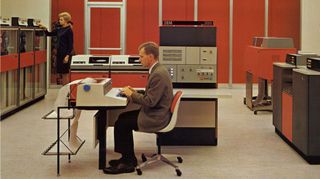The mainframe at 50: how 'big iron' kept its staying power
Will it lumber on for another 50 years?

This week marks the 50th anniversary of the technology that changed computing forever and remains at the heart of business, science, government and academia today: the mainframe computer.
From checking your bank account or trading stocks, to booking a flight or posting on your social media profile, the mainframe is the workhorse that powers our fast-paced global business economy.
It processes more transactions faster and at a lower cost per transaction than any other environment, and these benefits are still being experienced by businesses, with 80% of the world's corporate data still managed by mainframes.
Staying power
Why has this technology remained such an important mainstay of IT over the last 50 years? It's simple - innovation.
The mainframe's huge resource management capabilities have helped incubate new technologies and techniques like virtualization, resource management, high levels of security, and huge scalability – that have then cascaded down to other systems.
We're now facing the consumerization of IT and an increasingly tech savvy workforce with a BYOD and BYO apps mindset, and enterprise computing is rapidly evolving in order to be fit for purpose.
We may only be scratching the surface of what the digital age means for business, but trends like big data, cloud, the Internet of Things and mobile computing have given us a glimpse of what is possible. They are well established and driving phenomenal growth, but the demands on the business as a result of these trends can often outpace IT's capacity to deliver innovation.
Are you a pro? Subscribe to our newsletter
Sign up to the TechRadar Pro newsletter to get all the top news, opinion, features and guidance your business needs to succeed!
To the skies
As the number of mainframe transactions skyrocket, organizations are also under pressure to deliver more IT services while cutting costs. The mainframe is having to evolve in-line with this change, to give businesses the tools to meet today's challenges while laying the groundwork for the future.
One way that I believe this challenge can be met is through unifying mainframe management. By tying together some of the administrative functions like security, storage and infrastructure, businesses can simplify tasks, automate where possible, increase staff productivity and reduce the complexity of managing mission-critical mainframe workloads - well into the 21st century.
We're ushering in a new form of centralized computing driven by off-premise sourcing and today's anytime, anywhere access, and although some might refuse to admit it, the mainframe is stronger, more evolved, and more relied-upon than ever before as a result.
- Mike Madden is the General Manager, Mainframe at CA Technologies
Most Popular

